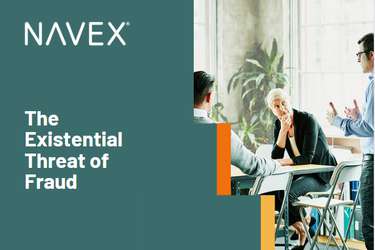Since the Fédération Internationale de Football Association, better known as FIFA, announced in 2010 that Qatar would be the site of the 2022 Men’s World Cup, bribery and corruption allegations have run rampant.
A quick recap of FIFA’s (not-so-greatest) hits can teach organizations a lot about corruption – especially about how to deal with it when it happens.
In 2010, FIFA picked Qatar over the United States to host the 2022 Men’s World Cup. But the previous few weeks were filled with incidents that called that selection into question.
Twenty-one days before the World Cup vote, Qatar offered FIFA $400 million, The Sunday Times reported later, citing leaked documents. The Times noted that Al Jazeera, Qatar’s state-run broadcaster, also signed a secret $100 million TV deal that would be paid if Qatar was voted in. Then, just nine days before the vote, French president Nicolas Sarkozy had lunch with soccer great Michel Platini (who went on to vote on the World Cup’s location) and Qatar’s crown prince Sheikh Tamim Bin Hamad Al Thani.
These events – along with the fact that Qatar had no soccer infrastructure, not much of a soccer culture, and summer temperatures that often go well into triple digits – raised more than a few eyebrows when the country was selected.
These events – along with the fact that Qatar had no soccer infrastructure, not much of a soccer culture, and summer temperatures that often go well into triple digits – raised more than a few eyebrows when the country was selected. On top of that, after the vote, Qatar Sports Investments bought Paris Saint-Germain F.C., a French professional soccer club, and Qatar Airways bought 50 Airbus planes from its French factory, The Guardian reported.
Not surprisingly, a flurry of allegations of bribery and corruption followed – and nine years later, the scandal is still in the news. Just a few weeks ago, Platini was detained in France for questioning. No charges have been announced, though he is serving a FIFA ban for financial misconduct.
If There are No Charges, What’s the Big Deal?
FIFA, of course, has been plagued by scandal and corruption for years, meaning that the situation surrounding Qatar’s selection is just one more instance that damages the organization’s reputation. This further emphasizes the snowball effect that our current era of instantaneous and explosive news propagation can have on a scandal. But as discussed during the higher ed bribery scandal, there are lots of things for executives and compliance professionals to learn, the most important of which involves trust and transparency – two areas in which FIFA has been lacking.
Read More: Transparency & Trust: The Underlying Themes of Top 10 Ethics & Compliance Trends
Once a scandal occurs, organizations need to immediately take public-facing steps to mitigate the issue, prevent downstream issues, and showcase accountability. These steps can include:
- Self-report: Organizations should voluntarily disclose the potential violation, along with all relevant facts and individuals involved, to regulators prior to the thread of government investigation. The timing is key. If the organization unreasonably delays reporting an offense to government authorities after becoming aware of it, then they may not receive credit for having an effective ethics and compliance program.
- Cooperate with authorities: Organizations should fully cooperate with regulatory investigators by preserving and disclosing all evidence, coordinating internal investigations with the regulator’s investigations and making relevant individuals available for the interviews. To ensure the cooperation is timely and thorough, the organization should provide that its compliance officer retains an open line of communication with regulators.
- Acknowledge mistakes: Organizations should demonstrate a timely and appropriate violation remediation by disciplining culpable employees and implementing an effective ethics and compliance program to prevent further similar violations. This may include designing and implementing new programs, reviewing and optimizing ongoing programs as well as accompanying risk assessments and training of compliance officers and other stakeholders with a strong focus on ethical culture.
In recent years the U.S. Department of Justice (DOJ) has taken important steps to incentivize self-disclosure among organizations. Pursuant to the DOJ’s FCPA Corporate Enforcement Policy, given all these criteria are met, and there are no ‘aggravating circumstances’ involved, the company will qualify for a declination.
FIFA hasn’t taken actions like this, but it’s been saved, according to some pundits over the years, by the billions of dollars it has in the bank. That’s something not all organizations can fall back on.
Chat with a solutions expert about your antibribery and corruption program.
FIFA Can Learn From Corporate Organizations
“Nobody talks about scandals or corruption – we talk about football. We can say that we’ve turned the situation around,” said FIFA president Gianni Infantino a few weeks ago. The next day, FIFA Vice President Ahmad was detained for questioning by French authorities.
Public comments (whether they’re believed or not) aren’t enough. FIFA and any organization struggling with allegations of corruption need to back up their words with actions – because government agencies around the world are watching more closely.
In recent years, the corporate sector has learned a lot from government agencies as the DOJ and the Securities and Exchange Commission (SEC) began cracking down globally on bribery and corruption. In 2018, the DOJ and the SEC brought FCPA enforcement actions totaling $1.3 billion in fines, penalties and disgorgement.
FIFA doesn’t fall under the regulatory oversight of agencies like the DOJ or the SEC – a researcher at the University of Colorado said it falls into a netherworld of governance – but all organizations can still learn important lessons from FIFA’s experiences.
With the perfect storm of regulatory crackdown intensified by the wildfire-like nature of reputation damaging news, organizations need strong compliance programs to prevent, mitigate and learn from every scandal.









